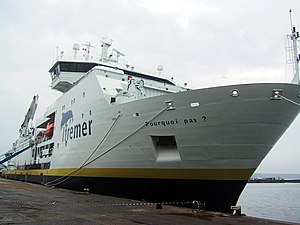|
French ship Pourquoi Pas? (2005)
Pourquoi Pas ? (English: Why Not?) is a research vessel built in Saint-Nazaire, France by Alstom Marine for IFREMER and the French Navy.[citation needed]It is currently primarily used by SHOM (Service hydrographique et océanographique de la Marine).[citation needed] It was ordered in December 2002 and completed in July 2005.[citation needed] The 66 million euro cost was financed by IFREMER (55%) and the French Navy (45%).[citation needed] She is named after explorer Jean-Baptiste Charcot's famous ship.[citation needed] A space is required immediately before a question mark in French orthography, and accordingly, in French Pourquoi Pas ? is the correct way to write the name. Pourquoi Pas ? is used 150 days per year by the French Navy and 180 days per year by IFREMER.[citation needed] It was designed for hydrography, geoscience, and physical, chemical, and biological oceanography, as well as to launch small submarines such as the crewed submersible Nautile and the ROV Victor 6000. Notably, Pourquoi Pas ? has been used for the 2007 deployment and connection operations for the ANTARES neutrino telescope.[citation needed] In 2008, Pourquoi Pas ? was used for the initial testing and operations of the PERISCOP, a pressurized deep sea fish recovery device.[citation needed] In June 2009, it was used to assist the recovery of Air France Flight 447.[citation needed]  External linksWikimedia Commons has media related to Pourquoi Pas ? (ship, 2005). Wikinews has related news:
This article was translated from the original article from the French Wikipedia, in 2006. |
||||||||||||||||||||||||||||||||||||||||||
